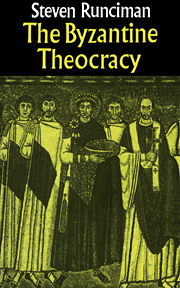Book contents
- Frontmatter
- Contents
- Foreword
- Introduction
- 1 The Christian Empire: The image of God upon earth
- 2 The Viceroy of God: The plenitude of Imperial power
- 3 The battle over images: The challenge of popular belief
- 4 The working compromise: The limits of Imperial control
- 5 The monks and the people: The opposition to the palace and the hierarchy
- 6 Decline and fall: The end of the Kingdom of God on earth
- Notes
- Index
4 - The working compromise: The limits of Imperial control
- Frontmatter
- Contents
- Foreword
- Introduction
- 1 The Christian Empire: The image of God upon earth
- 2 The Viceroy of God: The plenitude of Imperial power
- 3 The battle over images: The challenge of popular belief
- 4 The working compromise: The limits of Imperial control
- 5 The monks and the people: The opposition to the palace and the hierarchy
- 6 Decline and fall: The end of the Kingdom of God on earth
- Notes
- Index
Summary
The Emperor Leo III had introduced Iconoclasm high-handedly, on his own authority. Constantine V, though he had given himself the support of a Council of the Church, had been even more high-handed in enforcing the doctrine. Could it now be abandoned without damaging the prestige of the Imperial office? If a new priest-king were to promulgate a doctrine completely opposed to his predecessors', there must be something wrong with the priesthood. It was, perhaps, fortunate that the ruler who was determined to re–establish image–worship was not a priest–king. The Empress Mother Irene was, as a crowned Augusta, a recognized repository of Imperial power; and no one questioned her right to be Regent for her young son. But as a woman she could not be a priest. Her coronation had not included the element of ordination which a crowned Emperor received. She could not act as Pontifex and make her own pronouncements on theology, nor could the child-Emperor, her son. So, if she were to alter the religious policy of the Empire, she had to operate through the Church. The Church thereby to some extent won a constitutional victory, but it was won at the expense of a woman Regent, not of a Holy Emperor.
Irene was devout and genuinely devoted to image worship. But she had to act with caution. First, it was necessary to remove Iconoclastic officials. The civil service had to learn that preferment now depended on a proper respect for images. It was less easy to convince the army that Iconoclasm must be abandoned. Irene's attempts gradually to replace Iconoclastic military commanders by her own supporters were not always wise and were resented by the troops.
- Type
- Chapter
- Information
- The Byzantine TheocracyThe Weil Lectures, Cincinatti, pp. 77 - 109Publisher: Cambridge University PressPrint publication year: 1977



